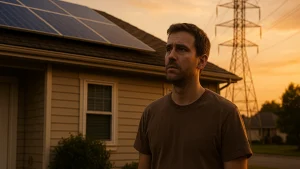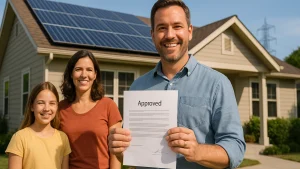Electric Bill Crisis: Why Solar Installation Must Happen in 2025

Why Your Customers Can’t Afford to Wait: The Hidden Electric Bill Crisis Driving Solar Urgency in 2025
What’s Really Happening to Electric Bills Across America?
Solar Installation in 2025: Electric rates are crushing homeowners nationwide, and the numbers tell a shocking story. In Massachusetts, residents have watched their electricity costs skyrocket over 100% in just 15 years. New York and Illinois regulators are greenlighting double-digit rate hikes, while Connecticut ratepayers pay over $1 billion annually in public benefits charges alone.
Why are electric bills rising so dramatically? The answer lies in aging infrastructure costs, renewable energy transition expenses, and utility company profit margins that homeowners unknowingly subsidize every month.
For solar installers, EPCs, and residential customers, this crisis creates both urgency and unprecedented opportunity.
How Are Policy Changes Affecting Solar Incentives Right Now?
The solar landscape is shifting rapidly due to recent legislative changes. Utilities across California, Florida, New York, and Connecticut are implementing aggressive strategies:
- Net metering compensation reductions of 20-75% in multiple states
- Fixed charge increases targeting solar households specifically
- Grid connection fees and standby charges for solar customers
- Time-of-use rate structures that reduce solar savings

Connecticut Senate Majority Leader Bob Duff warns: “Solar is no longer a luxury: it is an opportunity for long-term stability.” However, that stability window is closing as state utility commissions prioritize traditional utility revenue over customer savings.
What Are the Top Solar Myths Killing Your Sales? (Myth vs Reality Framework)
Myth #1: Does Solar Really Reduce My Home’s Value?
Reality: Homes equipped with solar photovoltaic systems sell 20% faster and command 6.9% higher sale prices compared to similar properties without solar installation in 2025. Lawrence Berkeley National Laboratory and Zillow research consistently shows solar as a premium home feature, especially in high-rate states like Massachusetts, New York, and Connecticut.
Myth #2: Should I Wait for Better Solar Panel Technology?
Reality: Every month customers delay costs real money. Current tier-1 solar panels from manufacturers like SunPower, Panasonic, and LG offer 25+ year warranties with proven performance. Meanwhile, the Inflation Reduction Act changes will increase average household electric bills by $110 in 2026 and over $400 annually by 2030.
Myth #3: Are Electric Bills Actually Cheaper Than Solar Payments?
Reality: Connecticut homeowners already pay for solar infrastructure through Public Benefits Charges totaling $1+ billion annually. Delivery charges for aging grid infrastructure often exceed actual electricity generation costs. Solar installations allow customers to own their power production instead of perpetually renting from utilities.
Myth #4: How Can I Afford Solar Installation Costs?
Reality: Over 70% of residential solar projects in 2024 used zero-down financing through solar loans, power purchase agreements (PPAs), or solar leases. Solar panel costs dropped 80% since 2010, from $6.25/watt to $3.36/watt average installed cost. Additionally, 34 states offer property tax exemptions, meaning increased home value without higher tax obligations.
Myth #5: Does Solar Work in Cloudy States Like New York?
Reality: Germany generates massive solar capacity with similar solar irradiance to Alaska. Japan became the world’s third-largest solar producer despite frequent cloud cover and limited land availability. Modern solar design software like Aurora Solar and HelioScope use 30+ years of National Weather Service data plus artificial intelligence to model precise energy production for any location.
Myth #6: What Happens When Solar Incentives Disappear?
Reality: Australia’s residential solar adoption accelerated after government rebates were reduced because homeowners realized energy independence transcends temporary incentives. Today, over 30% of Australian homes have solar installations – the highest global adoption rate.
Why Is Solar Financing Revolutionizing Customer Access?

Solar financing has evolved dramatically, eliminating traditional barriers for homeowners. Current financing options include:
Zero-Down Solar Loans: Major lenders like Sunlight Financial, Mosaic, and Dividend Finance offer qualified homeowners immediate installation with monthly payments often lower than current electric bills.
Power Purchase Agreements (PPAs): Companies like Sunrun, Tesla Solar, and Vivint Solar provide installations with no upfront costs, where customers pay only for solar energy produced.
Solar Leases: Fixed monthly payments regardless of energy production, with maintenance included through providers like SolarCity and local regional installers.
How Does Modern Technology Eliminate Solar Performance Uncertainty?
Today’s solar technology delivers measurable, predictable performance through advanced engineering and data analytics. Leading design platforms leverage:
Artificial Intelligence Integration: Aurora Solar’s AI-powered system analyzes satellite imagery, 3D modeling, and 30+ years of NOAA weather data to predict exact energy production before installation.
Performance Monitoring: Platforms like SolarEdge, Enphase, and SMA provide real-time production monitoring, allowing installers and homeowners to track system performance and identify issues immediately.
Manufacturing Quality: Tier-1 manufacturers including SunPower, Panasonic, LG, Canadian Solar, and Jinko Solar offer industry-leading warranties with proven long-term reliability data.
What Makes This the Optimal Time for Solar Installation?
Andrew Chintz, Treasurer of Bedford 2030 and Financing Specialist at NYC Accelerator, emphasizes current market conditions: “The incentives right now are frankly extraordinary, some of the most generous we have ever seen in New York and Connecticut. The incentives will decline with more market uptake, and today there are more political headwinds.”
Federal Incentives: The Investment Tax Credit (ITC) provides 30% federal tax credit through 2032, then steps down to 26% in 2033 and 22% in 2034.
State Programs: NYSERDA in New York, Connecticut Green Bank, and Massachusetts SMART program offer additional rebates and favorable financing terms.
Utility Net Metering: Current net metering policies in northeastern states provide 1:1 credit for excess solar production, but utilities are actively lobbying for reductions.
How Are Communities Benefiting from Strategic Solar Deployment?
Leo Wiegman, Director of Solar Programs for Sustainable Westchester, demonstrates community-scale solar impact: “Even with uncertainties at the federal level, the urgency remains. Our demand for electricity is rising faster than we are greening the grid. Solar is not just about savings — it is about resilience.”
Sustainable Westchester has coordinated solar installation in 2025 across dozens of municipalities, creating regional energy independence while reducing costs through group purchasing power.
What Should Solar Professionals Tell Customers About Market Timing?
The convergence of factors creates unprecedented urgency:
Rising Electric Rates: National average residential electricity rates increased 15% in 2024, with northeastern states experiencing higher increases.
Declining Incentives: State and utility solar programs are reducing benefits as adoption increases and utility lobbying intensifies.
Supply Chain Stability: Current solar equipment supply chains have stabilized after 2021-2022 disruptions, ensuring reliable installation timelines.
Interest Rate Environment: Federal Reserve policy changes affect solar loan rates, making current financing terms potentially more favorable than future options.
How Can Installers Position Solar as Essential Infrastructure?
Smart installers are repositioning solar from luxury upgrade to essential utility infrastructure. The messaging framework that resonates:
Energy Independence: Solar provides protection against utility rate volatility and grid reliability issues.
Financial Security: Fixed solar payments offer budget predictability versus escalating utility costs.
Home Value Enhancement: Solar installations in 2025 increase property values while reducing operating expenses.
Environmental Responsibility: Meeting customer sustainability goals while delivering economic benefits.
What’s the Bottom Line for 2025 Solar Installation Decisions?
Electric utility rate increases and vanishing solar incentives create compelling urgency for immediate installation. Customers face a critical decision point: secure current benefits or pay higher costs later.

The question isn’t “Can I afford solar?” but “Can I afford not to install solar while maximum benefits remain available?”
For Solar Installers and EPCs: This market timing creates ideal conditions for consultative selling focused on customer financial protection rather than environmental benefits alone.
For Homeowners: The combination of federal tax credits, state incentives, net metering, and current financing terms may never be more favorable.
Take Action While Maximum Benefits Remain Available
Solar installation in 2025 represents optimal market timing for customers seeking energy independence and financial security. Rising electric rates, mature technology, accessible financing, and current incentive structures create an unprecedented opportunity window.
Every month customers delay installation increases their long-term energy costs. Every policy change reduces future solar benefits. Every rate increase makes current solar economics more attractive.
The solar revolution isn’t approaching – it’s here. Your customers can participate while maximum benefits remain available, or pay higher costs later. The choice is theirs, but the opportunity won’t last indefinitely.
Seize the Moment with Energyscape Renewables
With electric rates surging and incentives beginning to fade, 2025 is the year to help customers act fast. But winning in this market requires precision, speed, and complete project support.
That’s where Energyscape Renewables makes the difference. We provide end-to-end solar engineering and design services—all in one place—from code-compliant plan sets and PE stamping to permitting, interconnection, and advanced system layouts.
Backed by our Sunscape Site Survey App and CRM platform, your teams can move faster, avoid costly delays, and deliver a top-tier customer experience while capturing maximum market share.
The window is open—but it won’t stay open long. Partner with Energyscape and lead your projects, your customers, and your business into a stronger future.

sjayakanth@energyscaperenewables.com